Systematic position, Diagnostic and General characters, Botanical description, Floral Formula, Economic Importance - Family: Liliaceae (Lily Family) | 11th Botany : Chapter 5 : Taxonomy and Systematic Botany
Chapter: 11th Botany : Chapter 5 : Taxonomy and Systematic Botany
Family: Liliaceae (Lily Family)

Monocot Family
Family: Liliaceae (Lily Family)
Systematic position
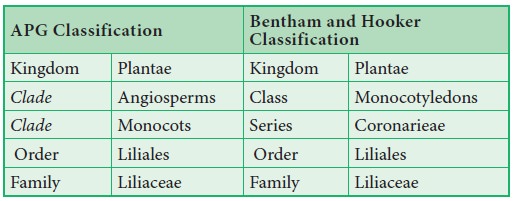
Diagnostic Features
·
Perennial herbs often with bulbous stem / rhizomes.
·
Radical leaves.
·
Perianth showy.
·
Stamens six.
·
Ovary superior.
General
Characters
Distribution:
Liliaceae
are fairly large family comprising
about 15 genera and 550 species. Members of this family are widely distributed
over most part of the world.
Habit: Mostly
perennial herbs persisting by means
of a sympodial rhizome (Polygonatum),
by a bulb (Lilium) corm ( Colchicum), shrubby or tree like (Yucca and Dracaena ). Woody climbers, climbing with the help of stipular
tendrils in Smilax. Trees in Xanthorrhoea, succulents in Aloe.
Note: Liliaceae of Bentham and Hooker included Allium, Gloriosa, Smilax, Asparagus, Scilla, Aloe, Dracaena etc. Now under APG, it includes only Lilium and Tulipa.
All others are placed under different families.
Root: Adventitious
and fibrous, and typically
contractile.
Stem: Stems
usually bulbous, rhizomatous in
some, aerial, erect (Dracaena) or
climbing (Smilax) in Ruscus the ultimate branches are
modified into phylloclades, In Asparagus stem is modified into cladodes
and the leaves are reduced to scales.
Leaf: Leaves
are radical ( Lilium) or cauline (Dracaena), usually alternate, opposite (Gloriosa), sometimes fleshy and hollow, reduced to scales (Ruscus and Asparagus). The venation is parallel but in species of Smilax it is reticulate. Leaves are
usually exstipulate, but in Smilax ,
two tendrils arise from the base of the leaf, which are considered modified stipules.
Inflorescence:
Flowers
are usually borne in simple or
branched racemes (Asphodelus) spikes
in Aloe, huge terminal panicle in Yucca, solitary and axillary in Gloriosa, solitary and terminal in Tulipa.
Flowers: Flowers
are often showy, pedicellate, bracteate,
usually ebracteolate except Dianella
and Lilium, bisexual, actinomorphic,
trimerous, hypogynous, rarely unisexual (Smilax)
and are dioecious, rarely tetramerous (Maianthemum),
slightly zygomorphic (Lilium) and
hypogynous.
Perianth:
Tepals 6
biseriate arranged in two whorls of
3 each, apotepalous or rarely syntepalous as in Aloe. Usually petaloid or sometimes sepaloid, odd tepal of the
outer whorl is anterior in position, valvate or imbricate, tepals more than six
in Paris quadrifolia.
Androecium: Stamens
6, arranged in 2 whorls of 3 each: rarely stamens are 3 (Ruscus),4 in Maianthemum,
or up to 12, apostamenous, opposite to the tepals, sometimes epitepalous;
filaments distinct or connate, anthers dithecous, basifixed or versatile,
extrose, or intrese, dehiscing usually by vertical slit and sometimes by
terminal pores; rarely synstamenous
(Ruscus).
Gynoecium:
Tricarpallary, syncarpous, the odd carpel usually
anterior, ovary superior, trilocular, with 2 rows of numerous ovules on axile
placextation; rarely unilocular with parietal placentation, style usually one;
stigmas 1 or 3; rarely the ovary is inferior (Haemodorum), nectar – secreting septal glands are
present in the ovary.
Fruit: Fruit
usually a septicidal or loculicidal
capsule or a berry as in Asparagus & Smilax.
![]()
![]()
![]()
Botanical
description of Allium cepa
(In APG classification, Allium cepa is placed under the family Amaryllidaceae)
Habit: Perennial
herb with bulb.
Root: Fibrous
adventitious root system
Stem: Underground
bulb
Leaf: a cluster
of radical leaves emerges from the
underground bulb, cylindrical and fleshy having sheathy leaf bases with
parallel venation.
Inflorescence:
Scapigerous i.e. the inflorescence
axis (peduncle) arising from the ground bearing a cluster of flowers at its
apex. Pedicels are of equal length, arising from the apex of the peduncle which
brings all flowers at the same level.
Flower: Small,
white, bracteate, ebrcteolate,
pedicellate, complete, trimerous, actinomorphic and hypogynous. Flowers are
protandrous.
Perianth:
Tepals 6,
white,arranged in two whorls of
three each, syntepalous showing valvate aestivation.
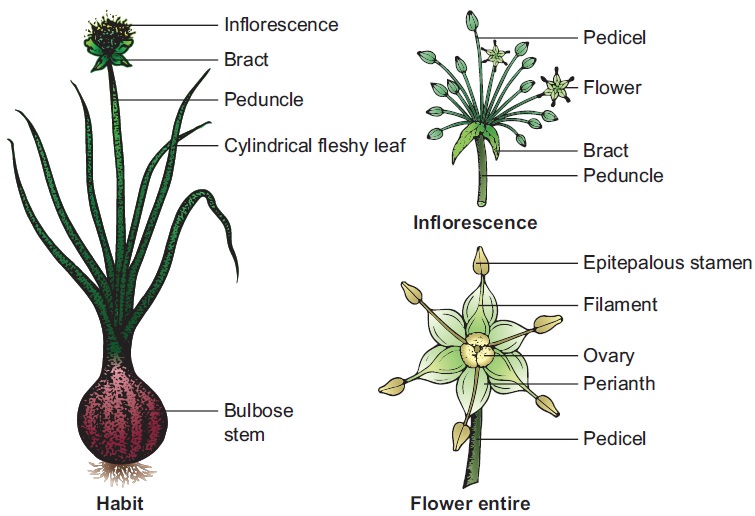
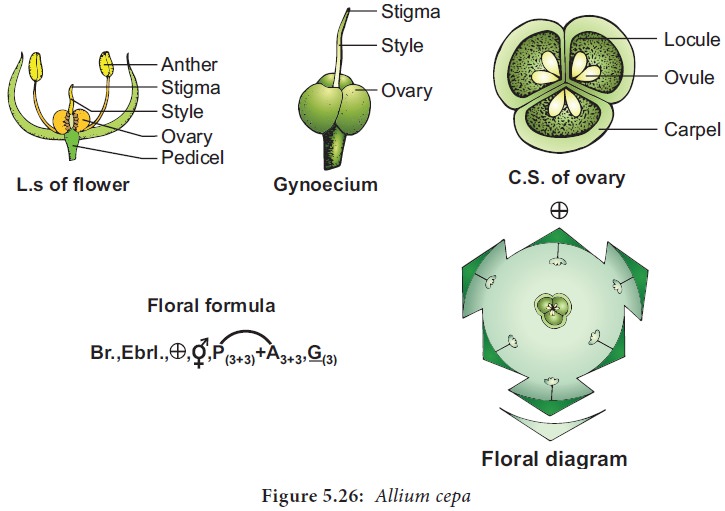
Androecium:
Stamens
6, arranged in two whorls of three
each, epitepalous, apostamenous /free and opposite to tepals. Anthers
dithecous, basifixed, introse, and dehiscing longitudinally.
Gynoecium:
Tricarpellary
and syncarpous. Ovary superior,
trilocular with two ovules in each locule on axile placentation. Style simple,
slender with simple stigma.
Fruit: A
loculicidal capsule.
Seed: Endospermous
Floral
Formula:

Economic importance of the family liliaceae
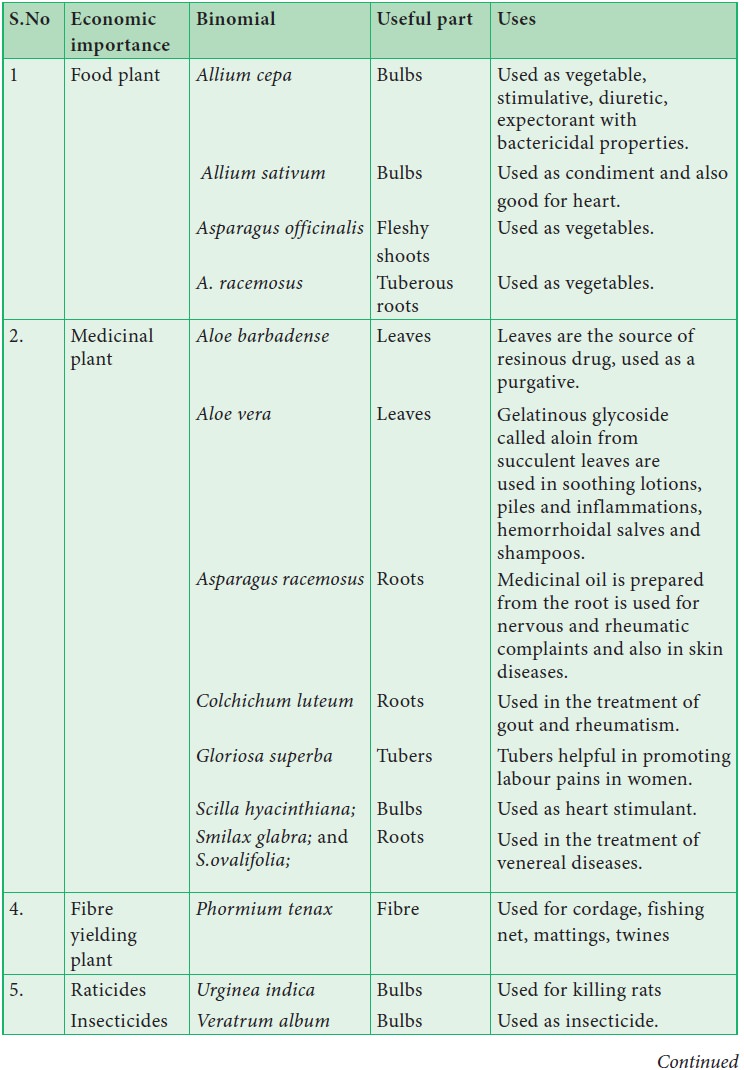
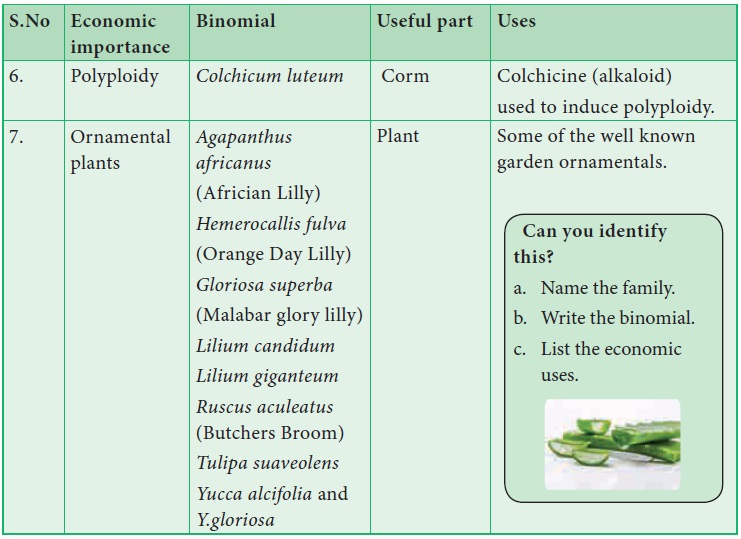
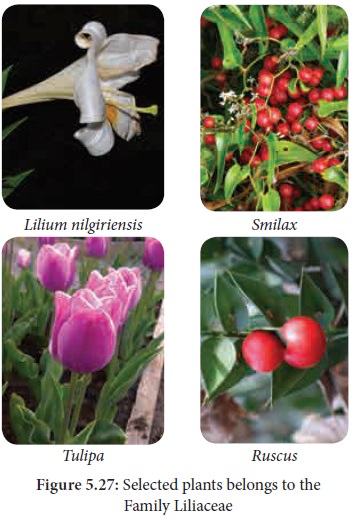
Related Topics